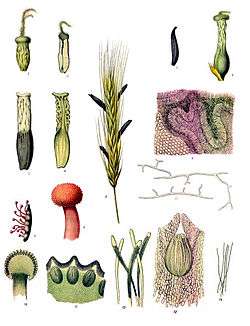Clavicipitaceae
| Clavicipitaceae | |
|---|---|
 | |
| Claviceps purpurea | |
| Scientific classification | |
| Kingdom: | Fungi |
| Division: | Ascomycota |
| Class: | Sordariomycetes |
| Order: | Hypocreales |
| Family: | Clavicipitaceae O.E.Erikss. (1982)[1] |
| Type genus | |
| Claviceps Tul. (1853) | |
| Genera | |
|
See text | |
The Clavicipitaceae are a family of fungi within the order Hypocreales. A 2008 estimate placed 43 genera in the family,[2] but recent work has increased this number to 97.
Phylogeny
Molecular phylogenetic analysis of multigene DNA sequence data indicates the taxon Clavicipitaceae is paraphyletic, and consists of three well-defined clades, at least one of which is shared with members of another fungal family (Hypocreaceae).[3] The evolution within the Clavicipitaceae is marked by interkingdom host jumping, and the range of this large and heterogeneous fungal group spans mutualistic plant symbionts, as well as parasites of plants, insects, and other fungi.[4]
Significance
Many of its members produce alkaloids toxic to animals and humans. One of its most infamous species is Claviceps purpurea, which has historical significance as the cause of St. Anthony's fire, also known as ergotism. Ergotism is caused by ergot alkaloids, such as ergotamine and ergocristine, which are chemical derivatives of lysergic acid. Metarhizium species are widely used in the biological control of insect pests.[5]
Genera
Several genera, especially those previously described as "anamorphic" (having no known sexual cycle) are now re-classified into other families, in light of recent molecular and other evidence. Mycobank currently (July 2018) lists the following genera in this family:[6]
- Aciculosporium
- Akrophyton
- Aschersonia
- Atkinsonella
- Atricordyceps
- Balansia
- Balansiella
- Balansiopsis
- Barya
- Baryella
- Belaina
- Berkelella
- Blistum
- Byssostilbe
- Campylothecium
- Cavimalum
- Cepsiclava
- Chamaeleomyces
- Chromostylium
- Claviceps
- Collarina
- Conoideocrella
- Corallocytostroma
- Cordycepioideus
- Cordylia
- Corynesphaera
- Diheterospora
- Dothichloë
- Drechmeria
- Dussiella
- Echinodothis
- Ephelis
- Epichloë
- Epicrea
- Ergotaetia
- Fleischeria
- Harposporium
- Helminthascus
- Heteroepichloë
- Hypocrella
- Hypocreophis
- Hypoxylum
- Kentrosporium
- Konradia
- Linearistroma
- Metacordyceps
- Metapochonia
- Metarhiziopsis
- Metarhizium
- Mitosporium
- Mitrasphaera
- Moelleria (fungus)
- Moelleriella
- Mothesia
- Mycomalus
- Mycophilomyces
- Myriogenis
- Myriogenospora
- Neobarya
- Neoclaviceps
- Neocordyceps
- Neotyphodium
- Nigelia
- Nigrocornus
- Nomuraea
- Ophiodothis
- Orbiocrella
- Palaeoclaviceps
- Parepichloë
- Phytocordyceps
- Pochonia
- Podocrella
- Polistophthora
- Polynema (fungus)
- Polyrhina
- Pseudomeria
- Racemella
- Regiocrella
- Romanoa (fungus)
- Samuelsia
- Shimizuomyces
- Spermoedia
- Sphacelia
- Sphaceliopsis
- Sphaerocordyceps
- Stereocrea
- Tettigorhyza
- Torrubia (fungus)
- Typhodium
- Tyrannicordyceps
- Underwoodina
- Ustilaginula
- Ustilagopsis
- Villosiclava
- Wakefieldiomyces
- Xylariopsis (fungus)
References
- ↑ Eriksson O. (1982). "Outline of the ascomycetes – 1982". Mycotaxon. 15: 203–48 (see p. , 224).
- ↑ Kirk PM, Cannon PF, Minter DW, Stalpers JA (2008). Dictionary of the Fungi (10th ed.). Wallingford: CABI. p. 150. ISBN 0-85199-826-7.
- ↑ Sung GH, Sung JM, Hywel-Jones NL, Spatafora JW (September 2007). "A multi-gene phylogeny of Clavicipitaceae (Ascomycota, Fungi): identification of localized incongruence using a combinational bootstrap approach". Mol. Phylogenet. Evol. 44 (3): 1204–23. doi:10.1016/j.ympev.2007.03.011. PMID 17555990.
- ↑ Spatafora JW, Sung GH, Sung JM, Hywel-Jones NL, White JF Jr (2007). "Phylogenetic evidence for an animal pathogen origin of ergot and the grass endophytes". Mol. Ecol. 16 (8): 1701–1711. doi:10.1111/j.1365-294X.2007.03225.x. PMID 17402984.
- ↑ Capinera JL. (2008). Encyclopedia of Entomology. Springer Science & Business Media. pp. 2354–7. ISBN 978-1-4020-6242-1.
- ↑ Mycobank: Clavicipitaceae (retrieved 21 July 2018)
- C.J. Alexopolous, Charles W. Mims, M. Blackwell et al., Introductory Mycology, 4th ed. (John Wiley and Sons, Hoboken NJ, 2004) ISBN 978-0-471-52229-4

